文章信息:Xiaoli Chen, Miaoxiao Wang, Laipeng Luo, Xiaonan Liu, Liyun An, Yong Nie, & Xiao-Lei Wu. (2024). The evolution of autonomy from two cooperative specialists in fluctuating environments. Proceedings of the National Academy of Sciences: 121(35), e2317182121. https://doi.org/10.1073/pnas.2317182121
整理人:杨文,2023级硕士生
整理时间:2024年8月23日
Abstract:From microbes to humans, organisms perform numerous tasks for their survival, including food acquisition, migration, and reproduction. A complex biological task can be performed by either an autonomous organism or by cooperation among several specialized organisms. However, it remains unclear how autonomy and cooperation evolutionarily switch. Specifically, it remains unclear whether and how cooperative specialists can repair deleted genes through direct genetic exchange, thereby regaining metabolic autonomy. Here, we address this question by experimentally evolving a mutualistic microbial consortium composed of two specialists that cooperatively degrade naphthalene. We observed that autonomous genotypes capable of performing the entire naphthalene degradation pathway evolved from two cooperative specialists and dominated the community. This evolutionary transition was driven by the horizontal gene transfer (HGT) between the two specialists. However, this evolution was exclusively observed in the fluctuating environment alternately supplied with naphthalene and pyruvate, where mutualism and competition between the two specialists alternated. The naphthalene-supplied environment exerted selective pressure that favors the expansion of autonomous genotypes. The pyruvate-supplied environment promoted the coexistence and cell density of the cooperative specialists, thereby increasing the likelihood of HGT. Using a mathematical model, we quantitatively demonstrate that environmental fluctuations facilitate the evolution of autonomy through HGT when the relative growth rate and carrying capacity of the cooperative specialists allow enhanced coexistence and higher cell density in the competitive environment. Together, our results demonstrate that cooperative specialists can repair deleted genes through a direct genetic exchange under specific conditions, thereby regaining metabolic autonomy.
摘要:从微生物到人类,生物体为生存执行许多任务,包括食物获取、迁移和繁殖。一项复杂的生物任务可以由一个自主的生物体或几个专门生物体之间的合作来执行。然而,目前尚不清楚自主和合作是如何演变的。具体而言,目前尚不清楚合作专家是否以及如何通过直接遗传交换修复缺失的基因,从而恢复代谢自主性。在这里,我们通过实验进化出一个由两名合作降解萘的专家组成的互惠微生物群落来解决这个问题。我们观察到,能够执行整个萘降解途径的自主基因型是由两名合作专家进化而来的,并主导了社区。这一进化转变是由两位专家之间的水平基因转移(HGT)推动的。然而,这种进化仅在萘和丙酮酸交替供应的波动环境中观察到,在这种环境中,两位专家之间的共生和竞争交替出现。萘供应环境施加了有利于自主基因型扩展的选择压力。丙酮酸供应环境促进了合作专家的共存和细胞密度,从而增加了HGT的可能性。通过数学模型,我们定量证明,当合作专家的相对增长率和承载能力允许在竞争环境中增强共存和更高的细胞密度时,环境波动有助于通过HGT实现自主性的进化。总之,我们的研究结果表明,合作专家可以在特定条件下通过直接遗传交换修复缺失的基因,从而恢复代谢自主性。
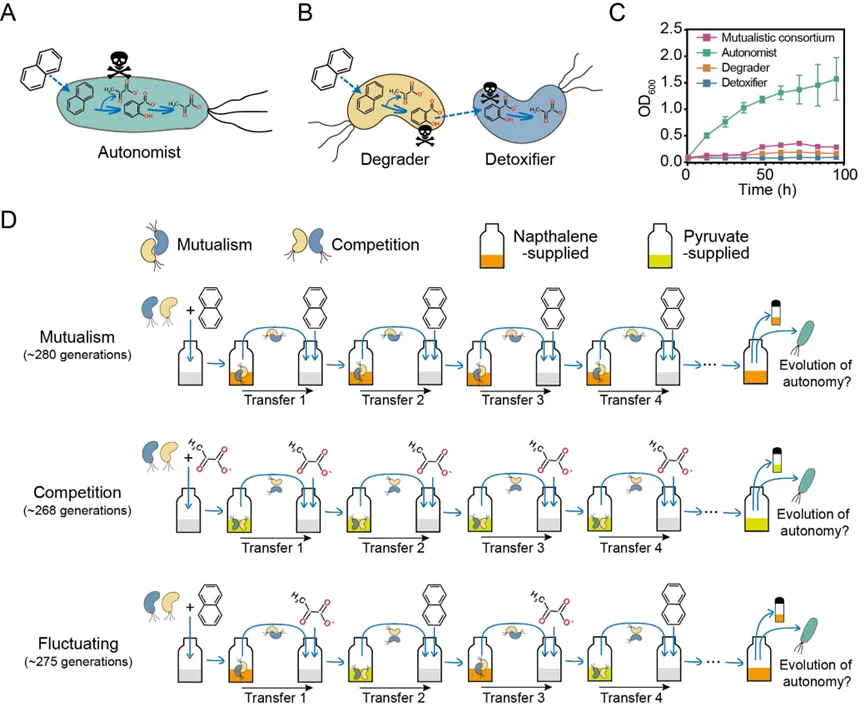
图 实验设计。
(A)能够完全降解萘的自主型菌株的示意图。(B)分工群落进行互利合作的示意图。第一株菌降解者,将萘降解为中间代谢物水杨酸;第二株菌解毒者,进一步将水杨酸代谢为丙酮酸等小分子物质。(C)以萘为唯一碳源时互利共生群落和自主型菌株的生长曲线。(D)进化实验设计示意图。在互利共生的条件下,每个传代周期都有萘的供应,因此群落中的两个菌株在整个进化过程中都处于互利合作的状态。在竞争条件下,每个传代周期都供应丙酮酸钠,因此两种菌株竞争生长。在振荡情况下,传代周期中交替供给萘或丙酮酸钠,因此两个菌株在不同的周期中交替进行互利共生或竞争生长。
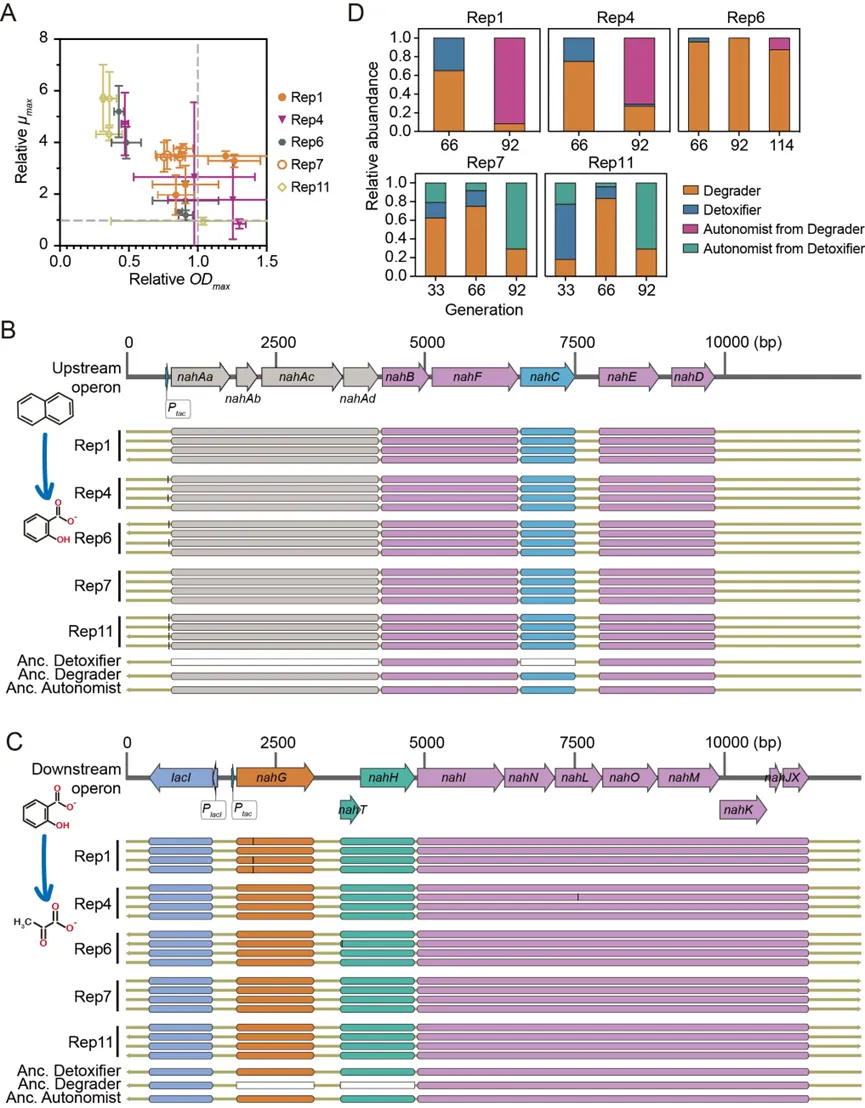
图 震荡环境下来自5个谱系的群落进化为自主型菌株。
(A)进化分离株和祖先自主型菌株之间生长动力学的比较。虚线表示祖先自主型菌株的水平。(B-C)祖先和进化菌株中两个萘操纵子的比较序列分析。(B)第一个操纵子包含负责将萘降解为水杨酸的基因,(C)第二个操纵子编码水杨酸进一步转化为丙酮酸的基因。不匹配由白框显示。(D)振荡环境下群落进化为自主型菌株的时间点测定。
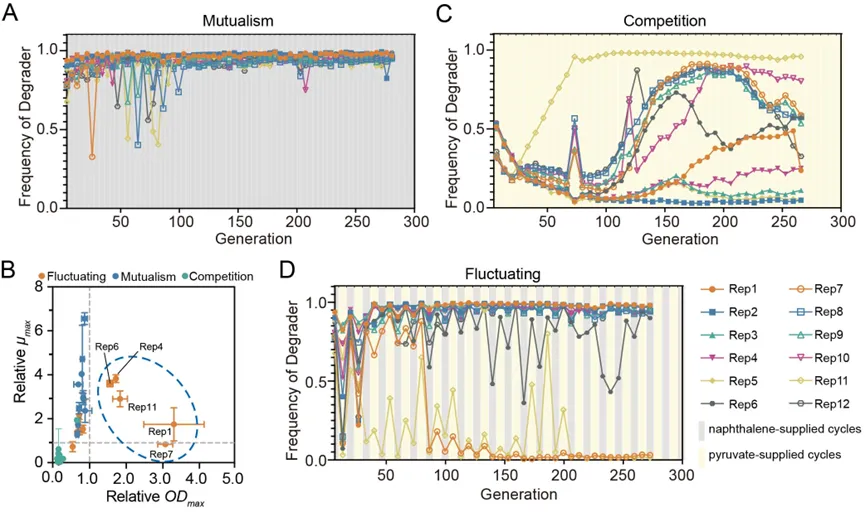
图 在三种环境下所有谱系传代过程中群落动态。
(A)互利共生、(C)竞争和(D)振荡条件下所有进化谱系的群落组成动态(由降解者的相对丰度表示)。(B)进化群落和祖先群落之间的生长动力学比较。本研究计算了每种条件下进化群落和祖先群落的最大细胞密度(ODmax)和最大生长速率(μmax),虚线表示祖先群落的生长水平。
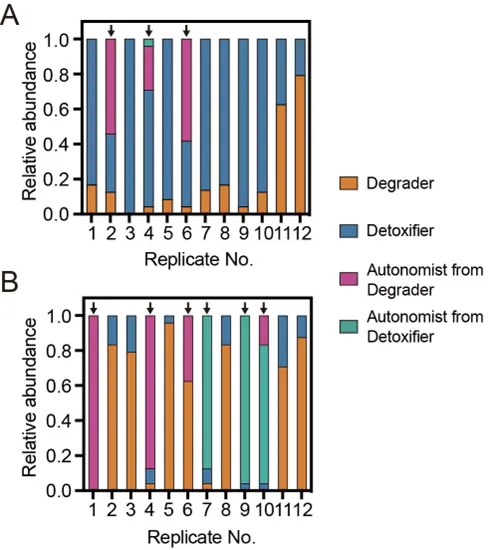
图 在恒定萘环境下补加解毒者有利于自主型菌株的进化。
22代后,(A)重新添加解毒者使得自主型菌株能够在OD600= 0.05的初始细胞密度下在12个重复中有3个进化出自主型菌株。(B)将群落的初始细胞密度增加到OD600 = 0.1,在12个重复中有6个进化出自主型菌株。
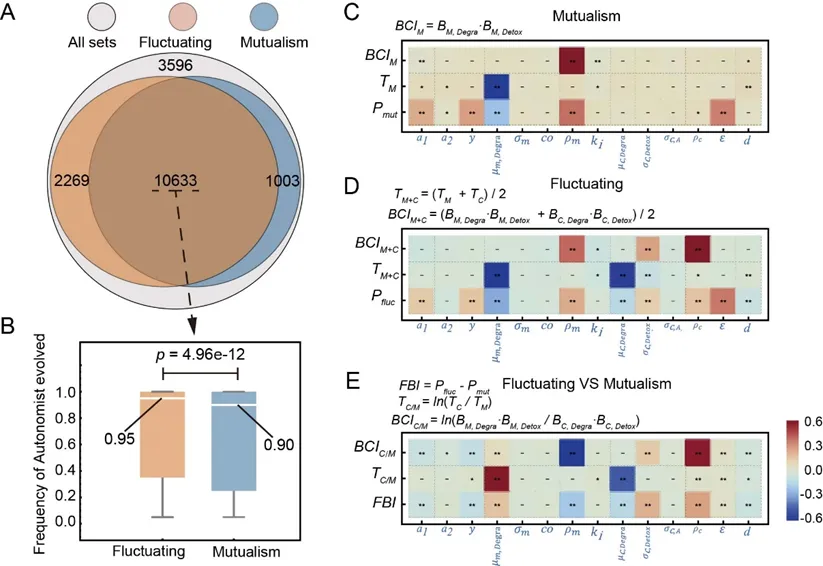
图 数学模型帮助探究实验结论的普适性
原文链接:https://www.pnas.org/doi/10.1073/pnas.2317182121
节选转引:https://mp.weixin.qq.com/s/22-ZGiPuU0i1myWHPeuszg